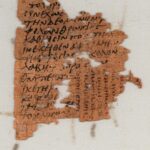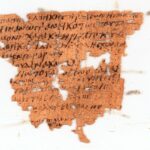| Artefact ID | 461 |
| TM ID | TM 59464 |
| Findspot (DEChriM ID) | - () | Class | Textual |
| Material | Papyrus |
| Writing medium | Codex |
| Text content | Literary |
| Language | Greek |
| Description | P.Köln VII 297; P.Koeln VII 297; KV9 a + b; KV 50 a; A papyrus fragment (10 x 11 cm) containing texts by Clemens Alexandrinus and Johannes Chrysostomus. The fragment is an opisthograph, and has been repurposed to accommodate later marginalia and new text on the verso (ed. pr. dates the second hand to the 5th c.). As the later text appears to be complete, it is possible to assume that it was added to the original papyrus sheet after it was cut and turned. The fragment is the oldest papyrus witness of Clemens of Alexandria. The principal text is patristic (KV 9a), and contains the work of Clemens Alexandrinus, Stromata VI 8.65.2-3. The text was written in an elegant book hand, similar to the Biblical majuscule, and was placed in the 4th c. by the ed. pr. This text does not contain any nomina sacra. Another text was later added to the margins of the recto, accommodated by the large size of margins (5 cm wide), in which the new text was written across the fibres. The text on the verso (written in the same hand as the marginalia) runs parallell to the text of the recto. These more recent texts (i.e., of the marginalia and verso) were written in slanting, pointed uncials with instances of diaereses, ellision and apostrophes, and are dated by the ed. pr. to the 5th c. The marginalia of the recto (KV 50a) present Johannes Chrysostomus In illud: Domine non est in homine (Jer. 10, 23). The verso (KV 9b) contains Clemens Alexandrinus' Stromata VI 8.69.23 together with 8.70.2 and 4. Only one nomen sacrum occurs (for θεός "God"). A Christian text with a similar mode of repurposing can be found in P.Mich. inv. 4922 (unknown Christian text written over the Cyropaedia of Xenophon, 4/5 c., provenance unknown). |
| Selection criteria | Literary genre (Theological), Nomina sacra |
| Date from | 300 |
| Date to | 499 |
| Dating criteria | Palaeography. Römer (through Aland 1995) places the text in the 5th c. (see Römer 1998: 131), but the ed. pr. places it in the 4th. |
| Absolute/relative date | Relative date |
| Archaeological context | Unknown. |
| Accession number | Cologne, Papyrussammlung P. 1763 |


 Json data
Json data





